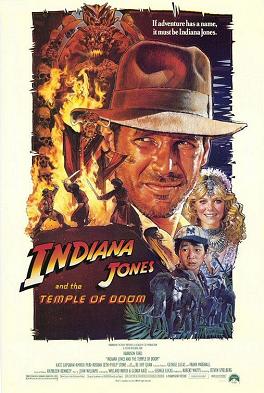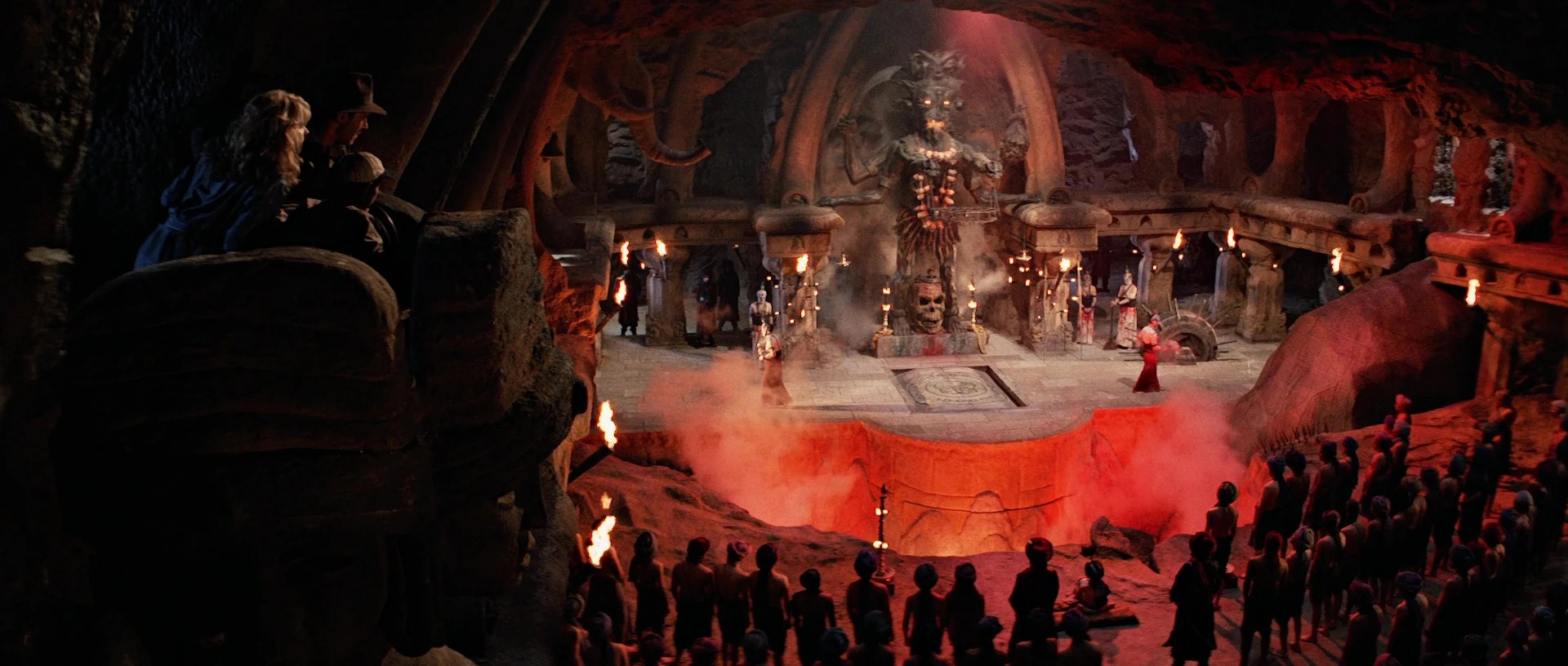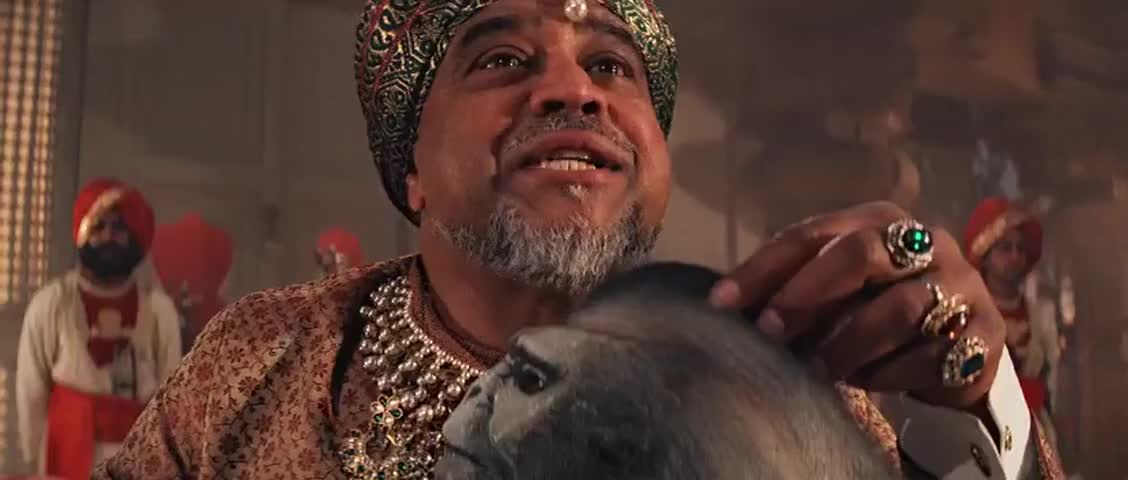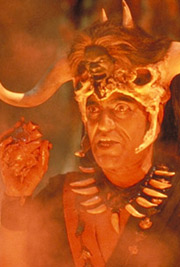 The Indiana Jones franchise was originally pitched by George Lucas as a trilogy of films, much in the style of adventure serials of the 1940s. Raiders of the Lost Ark was a tremendous success, popularizing and revolutionizing the fantasy adventure genre in much the same way that Star Wars had revolutionized science fiction film. And so with that success in mind, Director Steven Spielberg and Producer George Lucas set about working on the next film in the trilogy.
The Indiana Jones franchise was originally pitched by George Lucas as a trilogy of films, much in the style of adventure serials of the 1940s. Raiders of the Lost Ark was a tremendous success, popularizing and revolutionizing the fantasy adventure genre in much the same way that Star Wars had revolutionized science fiction film. And so with that success in mind, Director Steven Spielberg and Producer George Lucas set about working on the next film in the trilogy.When Lucas conceived of Temple of Doom, he imagined the film would stand within the Indiana Jones franchise much like The Empire Strikes Back stood within the Star Wars saga. The darker and grittier middle child that was more experimental and adult-oriented. Something that could steer the direction of the entire future franchise down an unexpected course, despite the intention of each film to be standalone adventures.
But where The Empire Strikes Back succeeded in its dark tone, Temple of Doom was much more controversial. The film was too dark for many audiences and especially the MPAA, who refused to give the film a PG rating. Knowing that an R-rating would kill the film in its cradle, Spielberg and Lucas worked with the MPAA to design an entirely new rating system, creating the PG-13 rating.
Temple of Doom's legacy within the Indiana Jones franchise remains a black sheep. Its middling performance revealed that it was more than the pure spectacle that drew audiences into the franchise. But was it deserving of its lukewarm reception?
***
- Directed by Steven Spielberg
- Produced by Lucasfilm Ltd.
- MPAA Rating: PG-13
- Running Time: 118 Minutes
***
SUMMARY
A year before his adventure in Raiders of the Lost Ark, Indiana Jones finds himself in Shanghai making a trade with a local crime boss for a historically significant diamond. When the trade goes south, Indiana Jones, alongside his young sidekick Short Round and singer Willie Scott, find themselves feeling Shanghai and eventually crash-landing in the middle of the Indian jungle.
In the jungle, Indiana Jones is put on the trail of the legendary Sankara Stones, artifacts of supposed legendary power in the Hindu faith, when the children of local villages are seemingly disappearing in the night. The trail leads to an ancient palace, a political conspiracy, and a dangerous death cult hellbent on using the Stones to acquire ultimate power.
In the jungle, Indiana Jones is put on the trail of the legendary Sankara Stones, artifacts of supposed legendary power in the Hindu faith, when the children of local villages are seemingly disappearing in the night. The trail leads to an ancient palace, a political conspiracy, and a dangerous death cult hellbent on using the Stones to acquire ultimate power.
***
REVIEW
Temple of Doom definitely has a different tone and feel to the rest of the franchise, feeling much more like a horror/adventure film in some scenes. The film still possesses much of the excitement and fun of the rest of the franchise, but an audience will have to fight through the darker tone and subject matter to reach it.
There is also the matter of the few instances of Orientalism that, while fitting in the style of a 1940s adventure serial, was dated and troubling back in the 1980s, let alone the 2020s.
But the film is still an entertaining ride, due to the high production value that we've come to expect from a Spielberg film. True it's not my favorite film in the franchise, but it is still Indiana Jones.
There is also the matter of the few instances of Orientalism that, while fitting in the style of a 1940s adventure serial, was dated and troubling back in the 1980s, let alone the 2020s.
But the film is still an entertaining ride, due to the high production value that we've come to expect from a Spielberg film. True it's not my favorite film in the franchise, but it is still Indiana Jones.
VISUALS - 8/10
This film is so much darker than the rest of the films in the franchise. Not only in terms of story, which we will definitely discuss in its section but from a lighting and scene composition perspective. The majority of the film takes place underground or in a deep jungle, giving the film an altogether different feel to the deserts of the first film. While this gives the film a very unique feel compared to the rest of the series, the darkness is both a blessing and a curse.
In film school, we were taught that all film is, in essence, using light as a creative medium. The act of film-making is carefully balancing out light and darkness to properly evoke the emotions and story that the creator wishes to convey. The literal darkness of this film works in many ways to convey a sense of mystery, danger, and horror. But when it comes time for the more triumphant and heroic moments, that darkness ends up occasionally muddling the scenes and washing out the action. Thankfully, this is really only a minor nitpick and it doesn't take away from the true visual strength of this film.
The stellar set design. The actual Thuggee Temple is an absolutely extraordinary piece of practical set design. Intricately and meticulously crafted to evoke maximum horror and alienness, even if the actual design is more evocative of Aztec and African designs than Indian. That same design style passes into the costume design as well, especially for the villain Mola Ram. This level of set design is thankfully matched by a return of the stunning action work that is so quintessential to the Indiana Jones franchise. The best fight sequence definitely has to be the fight between Indiana and the Slave Driver, which, in my mind, easily the most horrifying death of the "Dragon" (the trope name for the second-in-command evil guy) until the death of the Russian general in Kingdom of the Crystal Skull (though that might be my entomophobia talking).
There is also the matter of the final bridge sequence, which does look quite goofy to modern sensibilities, but that is a product of its time and doesn't really distract from the incredible action of the finale.
Temple of Doom has its issues to be certain. The muddled color palette of the second half of the film, mixed with some dated computer effects forces me to take some marks off for a modern viewing audience, but the sheer quality of Spielberg's set design and action choreography is just so masterful that I can't help but give it high marks.
In film school, we were taught that all film is, in essence, using light as a creative medium. The act of film-making is carefully balancing out light and darkness to properly evoke the emotions and story that the creator wishes to convey. The literal darkness of this film works in many ways to convey a sense of mystery, danger, and horror. But when it comes time for the more triumphant and heroic moments, that darkness ends up occasionally muddling the scenes and washing out the action. Thankfully, this is really only a minor nitpick and it doesn't take away from the true visual strength of this film.
 |
| The titular Temple looks so cool! |
The stellar set design. The actual Thuggee Temple is an absolutely extraordinary piece of practical set design. Intricately and meticulously crafted to evoke maximum horror and alienness, even if the actual design is more evocative of Aztec and African designs than Indian. That same design style passes into the costume design as well, especially for the villain Mola Ram. This level of set design is thankfully matched by a return of the stunning action work that is so quintessential to the Indiana Jones franchise. The best fight sequence definitely has to be the fight between Indiana and the Slave Driver, which, in my mind, easily the most horrifying death of the "Dragon" (the trope name for the second-in-command evil guy) until the death of the Russian general in Kingdom of the Crystal Skull (though that might be my entomophobia talking).
There is also the matter of the final bridge sequence, which does look quite goofy to modern sensibilities, but that is a product of its time and doesn't really distract from the incredible action of the finale.
Temple of Doom has its issues to be certain. The muddled color palette of the second half of the film, mixed with some dated computer effects forces me to take some marks off for a modern viewing audience, but the sheer quality of Spielberg's set design and action choreography is just so masterful that I can't help but give it high marks.
SOUNDTRACK - 9/10
In truth, I don't really have all that much to add to this section that I did not previously cover in my Raiders of the Lost Ark review. The soundtrack was, once again, composed by the great John Williams and is a beautiful mix of adventure and romance, though Temple of Doom adds in a heavy dose of darkness and horror to fit with the rest of the film's gritty subject matter.
In truth, I actually think I like the soundtrack in Temple of Doom as a whole much more than the other film's soundtracks. The track Temple of Doom sounds like something out of exorcist film or a DOOM game and I love it so much. And the track, Slave Children's Crusade, reminds me very much of the original Indiana Jones and the Temple of Doom arcade ROM-hack that I used to play on my dad's computer.
All in all, despite the film itself being my second least favorite of the franchise, the soundtrack is just so damn cool and fun that I can't help but think of this soundtrack when I think of Indiana Jones.
In truth, I actually think I like the soundtrack in Temple of Doom as a whole much more than the other film's soundtracks. The track Temple of Doom sounds like something out of exorcist film or a DOOM game and I love it so much. And the track, Slave Children's Crusade, reminds me very much of the original Indiana Jones and the Temple of Doom arcade ROM-hack that I used to play on my dad's computer.
All in all, despite the film itself being my second least favorite of the franchise, the soundtrack is just so damn cool and fun that I can't help but think of this soundtrack when I think of Indiana Jones.
CHARACTERS - 7/10
Like most of the Indiana Jones franchise, the size of the cast is relatively small. Despite this, the characters are able to leave a strong and memorable impact thanks to the quality performances given by their respective actors.
In Raiders of the Lost Ark, we are presented with an Indiana Jones who seems fairly heroic and good. Temple of Doom presents an altogether different approach to the stalwart adventurer - thanks to the legendary performance of Harrison Ford. It reminds us that, at his heart, Indiana Jones is a treasure hunter, interested in fortune and glory just as much as characters like Belloc were in Raiders. We go through the film waiting for Indiana to come to the moral conclusions that we as an audience have already made and this darker take on the character fits perfectly into the narrative tone of the story.
Assisting in this endeavor is his sidekick, Short Round. Played by Johnathan Ke Quan, Short Round was Johnathan's acting debut (his performance here would convince Spielberg to place him among the cast of his next film The Goonies ). Short Round acts as the moral compass of the trio of protagonists. He is the one most immediately witnessing the horrors being committed by the Thuggee cult, being a child himself. And it is through his efforts that Indiana is freed and able to overcome the cult and emerge victorious. I will admit that Short Round's accent and delivery can be a little difficult to get through sometimes but the actor is charismatic enough and the timing is good enough to get a fairly consistent laugh 9 times out of 10.
The last of the protagonists would be the romantic lead, American singer Willie Scott, played by Kate Capshaw. Willie was designed from the outset to be a complete contrast to Marion Ravenwood, the romantic lead of Raiders, even right down to the hair. Willie seems to be intended as an audience surrogate, allowing us to be introduced to the world of Indiana Jones through eyes unfamiliar with that kind of adventure. Unfortunately, those eyes can be quite annoying.
Kate Capshaw is an incredible actress and Willie Scott does have quite a few moments of genuine hilarity, especially in her interactions with Indiana Jones. It's just that she spends almost all of her time screaming. Willie Scott is one of the most notorious scream queens in film history. And while it makes sense given the content of the film, I can't help but be driven a little batty at the constant noise.
But what are the protagonists without an associated antagonist? Mola Ram acts as the primary antagonist of the film, leading the Thuggee cult with brainwashing and strange abilities that border on magic. This role made the career for actor Amrish Puri and it makes sense. While Mola Ram doesn't have the level of charisma that Belloc does or the danger of Donovan, he represents a more primal and savage kind of villain. Mola Ram is a psychopath of the highest order and seems to relish in the pain and torture that he commits. While many of the qualities that he possesses are based more on Voodoo or Aztec practices, rather than Hindi, Mola Ram truly stands out among the Indiana Jones villains. But he does suffer for his lack of connection to our heroes. Mola Ram has no real connection or ties to Indiana Jones, the two meet about halfway through the film for the first time.
The cast is an incredibly strong one. But the annoying tendencies of Willie Scott, the delivery of a few Short Round lines, and the impersonality of Mola Ram do hamper the overall score, but only minorly.
In Raiders of the Lost Ark, we are presented with an Indiana Jones who seems fairly heroic and good. Temple of Doom presents an altogether different approach to the stalwart adventurer - thanks to the legendary performance of Harrison Ford. It reminds us that, at his heart, Indiana Jones is a treasure hunter, interested in fortune and glory just as much as characters like Belloc were in Raiders. We go through the film waiting for Indiana to come to the moral conclusions that we as an audience have already made and this darker take on the character fits perfectly into the narrative tone of the story.
Assisting in this endeavor is his sidekick, Short Round. Played by Johnathan Ke Quan, Short Round was Johnathan's acting debut (his performance here would convince Spielberg to place him among the cast of his next film The Goonies ). Short Round acts as the moral compass of the trio of protagonists. He is the one most immediately witnessing the horrors being committed by the Thuggee cult, being a child himself. And it is through his efforts that Indiana is freed and able to overcome the cult and emerge victorious. I will admit that Short Round's accent and delivery can be a little difficult to get through sometimes but the actor is charismatic enough and the timing is good enough to get a fairly consistent laugh 9 times out of 10.
The last of the protagonists would be the romantic lead, American singer Willie Scott, played by Kate Capshaw. Willie was designed from the outset to be a complete contrast to Marion Ravenwood, the romantic lead of Raiders, even right down to the hair. Willie seems to be intended as an audience surrogate, allowing us to be introduced to the world of Indiana Jones through eyes unfamiliar with that kind of adventure. Unfortunately, those eyes can be quite annoying.
Kate Capshaw is an incredible actress and Willie Scott does have quite a few moments of genuine hilarity, especially in her interactions with Indiana Jones. It's just that she spends almost all of her time screaming. Willie Scott is one of the most notorious scream queens in film history. And while it makes sense given the content of the film, I can't help but be driven a little batty at the constant noise.
But what are the protagonists without an associated antagonist? Mola Ram acts as the primary antagonist of the film, leading the Thuggee cult with brainwashing and strange abilities that border on magic. This role made the career for actor Amrish Puri and it makes sense. While Mola Ram doesn't have the level of charisma that Belloc does or the danger of Donovan, he represents a more primal and savage kind of villain. Mola Ram is a psychopath of the highest order and seems to relish in the pain and torture that he commits. While many of the qualities that he possesses are based more on Voodoo or Aztec practices, rather than Hindi, Mola Ram truly stands out among the Indiana Jones villains. But he does suffer for his lack of connection to our heroes. Mola Ram has no real connection or ties to Indiana Jones, the two meet about halfway through the film for the first time.
The cast is an incredibly strong one. But the annoying tendencies of Willie Scott, the delivery of a few Short Round lines, and the impersonality of Mola Ram do hamper the overall score, but only minorly.
STORY - 6/10
Temple of Doom's story is incredibly complex and not in a good way. Most Indiana Jones stories are incredibly simple and linear. In Raiders of the Lost Ark, Indiana Jones is asked by the U.S. Government to find the Ark of the Covenant before the Nazi's do. Last Crusade and Crystal Skull are similar in that regard.
But Temple of Doom? An exchange of two valuable artifacts in a casino in Shanghai goes south and leads to our heroes being stranded in the middle of the Indian jungle where they happen to stumble across a random village whose children are going missing. Those missing children can all be tied to a nearby palace. From there a massive conspiracy to end British rule in India, conquer the world for a dark god, and child slavery ring all spiral into a befuddled mess that I can still only barely comprehend.
The film is tremendously confusing at times, often seeming to switch on whether or not something is magical or not. The Indiana Jones franchise has always been open to the supernatural but always left an air of mystery as to whether the religious iconography has real divine power or is merely unexplained science. But Temple of Doom's Sankara Stones and mind control blur that lines into near absurdity.
The film is heavily reliant on Orientalism for its mystery and sense of danger. It relies on Western audiences not knowing much about Hindu belief systems to heighten our immersion into Indiana's plight. The infamous Monkey Brains scene still makes me cringe just for what it represents in terms of cultural representation. And in fact, this film might actually be some Western audiences' first impression of Indian culture or Hindu beliefs, and that is deeply concerning. It was concerning in the 1980s and it is extremely concerning now.
All in all, these issues make the story easily the weakest of the franchise. It is something of a muddled mess and you end up not caring all that much about the goals of the characters beyond Indiana Jones stops the bad guys, gets the girl, and finds the lost treasure.
But Temple of Doom? An exchange of two valuable artifacts in a casino in Shanghai goes south and leads to our heroes being stranded in the middle of the Indian jungle where they happen to stumble across a random village whose children are going missing. Those missing children can all be tied to a nearby palace. From there a massive conspiracy to end British rule in India, conquer the world for a dark god, and child slavery ring all spiral into a befuddled mess that I can still only barely comprehend.
The film is tremendously confusing at times, often seeming to switch on whether or not something is magical or not. The Indiana Jones franchise has always been open to the supernatural but always left an air of mystery as to whether the religious iconography has real divine power or is merely unexplained science. But Temple of Doom's Sankara Stones and mind control blur that lines into near absurdity.
 |
| This absurd bastard is notorious. |
All in all, these issues make the story easily the weakest of the franchise. It is something of a muddled mess and you end up not caring all that much about the goals of the characters beyond Indiana Jones stops the bad guys, gets the girl, and finds the lost treasure.
FINAL THOUGHTS
Indiana Jones and the Temple of Doom truly is the black sheep of the original Indiana Jones trilogy. It's dark subject matter and themes paint a grim adventure with more than a few nightmare-inducing horror moments. The complicated and muddled story is held up by high production values, a stellar cast, and one of the best soundtracks in any Indiana Jones film.
While critics at the time were deeply cynical towards the film, I have a bit of a warm place in my heart for this oddball.
We will continue on with the third film in the franchise in two weeks' time. Before that, however, I will have a new countdown released next week. I hope you all bring your ears to that one as we have a musical countdown.
VISUALS
- 8/10
SOUNDTRACK
- 9/10
CHARACTERS
- 7/10
STORY
- 6/10


No comments:
Post a Comment